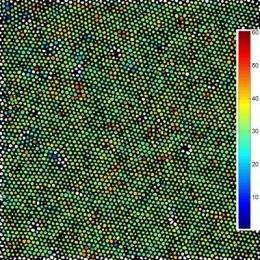'Spincasting' holds promise for creation of nanoparticle thin films

(PhysOrg.com) -- Researchers from North Carolina State University have investigated the viability of a technique called "spincasting" for creating thin films of nanoparticles on an underlying substrate – an important step in the creation of materials with a variety of uses, from optics to electronics.
Spincasting, which utilizes centrifugal force to distribute a liquid onto a solid substrate, already has a variety of uses. For example, it is used in the electronics industry to deposit organic thin films on silicon wafers to create transistors.
For this study, the researchers first dispersed magnetic nanoparticles coated with ligands into a solution. The ligands, small organic molecules that bond directly to metals, facilitate the even distribution of the nanoparticles in the solution – and, later, on the substrate itself.
A drop of the solution was then placed on a silicon chip that had been coated with a layer of silicon nitride. The chip was then rotated at high speed, which spread the nanoparticle solution over the surface of the chip. As the solution dried, a thin layer of nanoparticles was left on the surface of the substrate.
Using this technique, the researchers were able to create an ordered layer of nanoparticles on the substrate, over an area covering a few square microns. "The results are promising, and this approach definitely merits further investigation," says Dr. Joe Tracy, an assistant professor of materials science and engineering at NC State and co-author of a paper describing the study.
Tracy explains that one benefit of spincasting is that it is a relatively quick way to deposit a layer of nanoparticles. "It also has commercial potential as a cost-effective way of creating nanoparticle thin films," Tracy says.
However, the approach still faces several hurdles. Tracy notes that modifications to the technique are needed, so that it can be used to coat a larger surface area with nanoparticles. Additional research is also needed to learn how, or whether, the technique can be modified to achieve a more even distribution of nanoparticles over that surface area.
Analysis of the nanoparticle films created using spincasting led to another development as well. The researchers adapted analytical tools to evaluate transmission electron microscopy images of the films they created. One benefit of using these graphical tools is their ability to identify and highlight defects in the crystalline structure of the layer. "These methods for image analysis allow us to gain a detailed understanding of how the nanoparticle size and shape distributions affect packing into monolayers," Tracy says.
More information: The paper, "Formation and Grain Analysis of Spin Cast Magnetic Nanoparticle Monolayers," is forthcoming from the journal Langmuir.
Provided by North Carolina State University
















